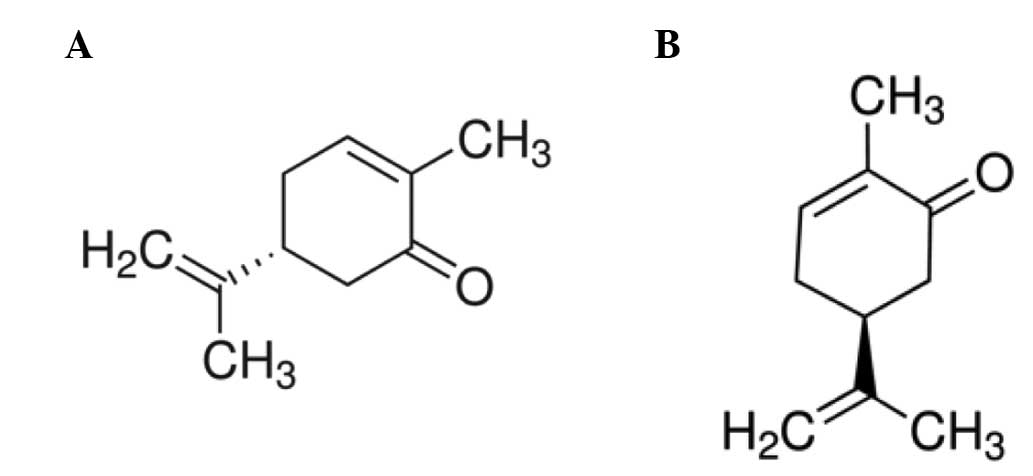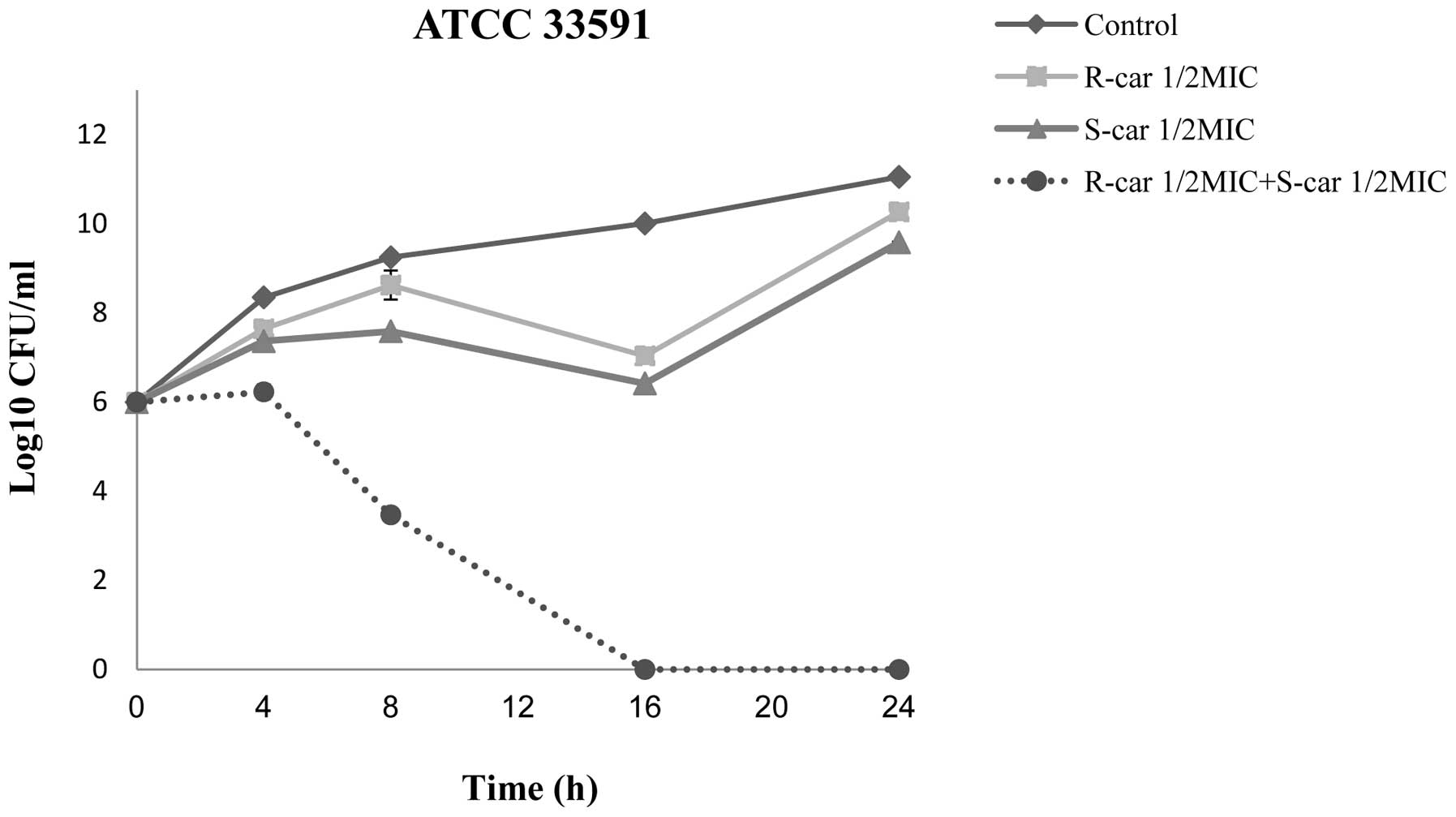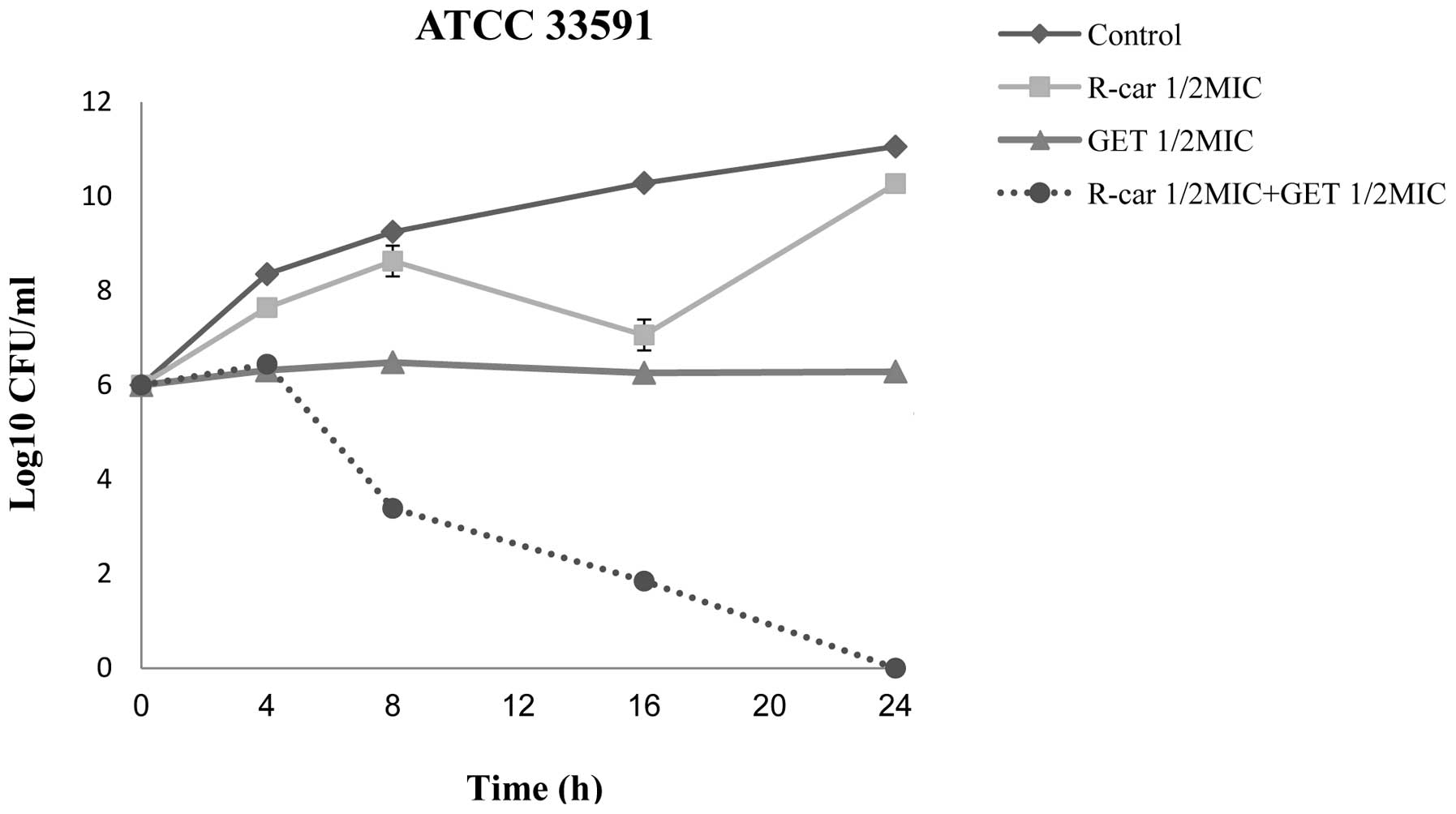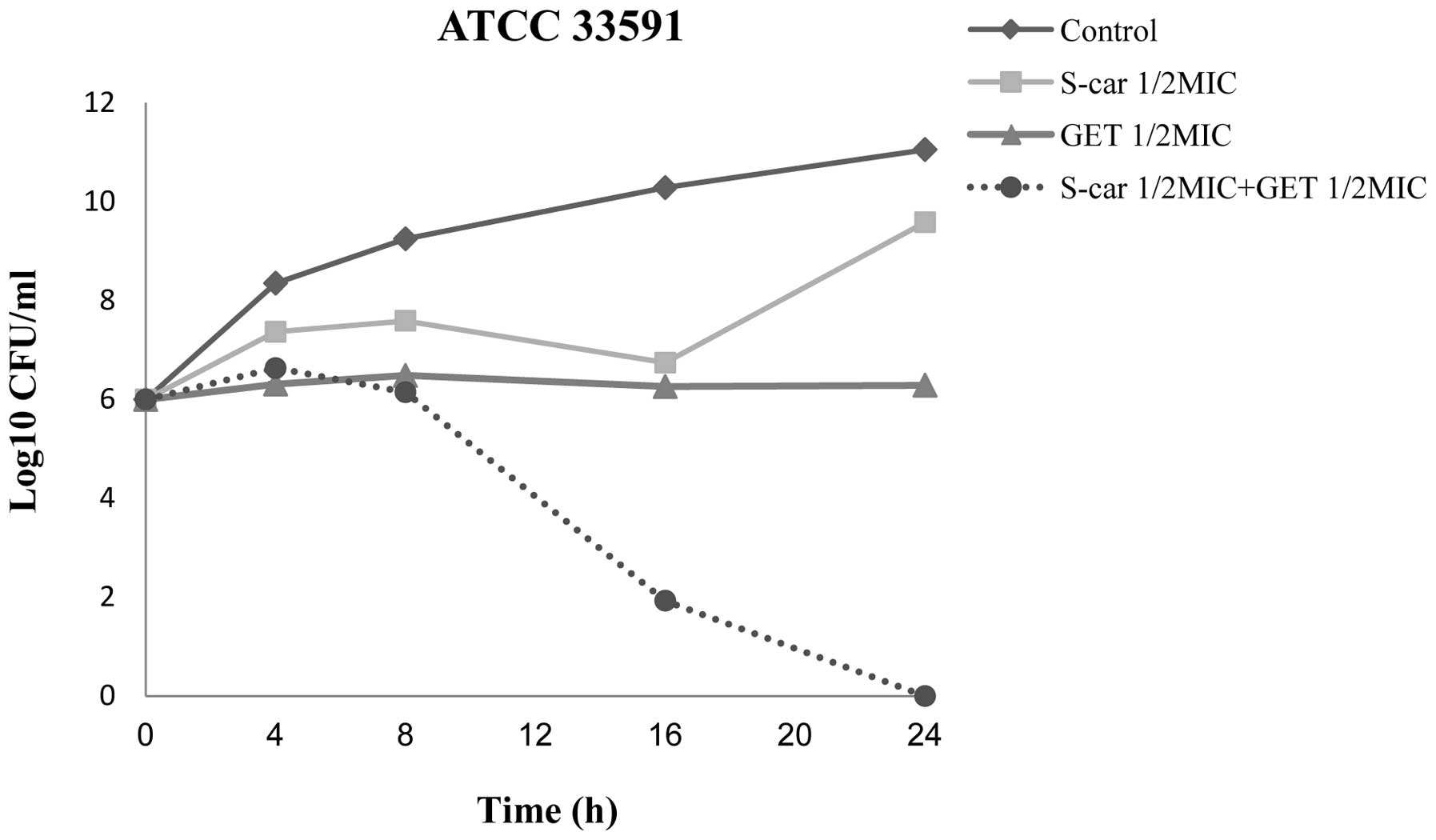Introduction
The monoterpene carvone is an enantiomeric compound.
R-carvone (R-car) smells like spearmint and is found naturally in
numerous essential oils, while S-car is the principal constituent
of caraway seed oil (Fig. 1)
(1). Carvone is a chiral molecule
and its enantiomers are non-superimposable mirror images of each
other that exhibit distinct chemical properties. Enantiomers are
important in pharmacology as chimeric drugs may comprise one
enantiomer that is responsible for the desired physiological change
and a second enantiomer that is inactive or elicits adverse effects
(2,3). Previous studies on the carvone
enantiomers have demonstrated an enantioselective
penetration-enhancing effect and an enantioselective influence on
the structure and function of a microbial river water system
(4,5). Furthermore, it has been revealed that
stereoselectivity in phase-I and -II metabolism has significant
effects on the pharmacokinetics of R- and S-car (6). However, to the best of our knowledge,
the antimicrobial activity of carvone against methicillin-resistant
Staphylococcus aureus (MRSA) has not been investigated.
Methicillin was discovered by Alexander Fleming in
1928, and has been used to clinically treat staphylococcal
infections since 1959 (7).
Methicillin resistance is generated by the acquisition of genes
encoding penicillin-binding proteins (PBPs), which have low
affinities for β-lactam antibiotics. Therefore, MRSA is generated
when methicillin-susceptible S. aureus acquires the
methicillin resistance gene mecA (8). S. aureus is a gram-positive
pathogen that causes a variety of systemic infections, including
hospital-acquired pneumonia, surgical wound infections and exotoxin
syndromes (9). In recent years,
the virulence of MRSA has acounted for nearly 70% of S.
aureus infections, and the rapid emergence of antibiotic
resistant strains has made it difficult to treat these infections
(10). Therefore, novel
therapeutic approaches are necessary to minimize bacterial
resistance against conventional antibiotics. The aim of the present
study was to determine the anti-MRSA activities of the combination
of R-car and S-car, and the combination of either carvone
enantiomer with gentamicin (GET).
Materials and methods
Reagents
R- and S-car were obtained from Tokyo Chemical
Industry Co., Ltd. (Tokyo, Japan). Mueller-Hinton agar (MHA) and
Mueller-Hinton broth (MHB) were purchased from Becton, Dickinson
and Company (Franklin Lakes, NJ, USA).
Tris(hydroxymethyl)aminomethane was obtained from Amresco LLC (San
Francisco, CA, USA), and sodium azide (NaN3) and
peptidoglycan were purchased from Fluka Chemie GmbH (Buchs,
Switzerland). GET, Triton X-100, N,N-dicyclohexylcarbodiimide and
purified lipopolysaccharide were obtained from Sigma-Aldrich Co.
LLC (St. Louis, MO, USA).
Bacterial strains and growth
conditions
Among the six strains of S. aureus that were
used in this study, four were clinical MRSA isolates obtained from
four patients who were treated at Wonkwang University Hospital
(Iksan, Korea). These strains were referred to as staphylococcal
strains from the Department of Plastic Surgery (DPS)-1, -2, -3 and
-4. The remaining two S. aureus strains, ATCC 33591 (MRSA)
and the methicillin-susceptible strain ATCC 25923, were
commercially available (American Type Culture Collection, Manassas,
VA, USA). All bacteria were stored in 30% glycerol and frozen at
−70°C. Prior to each experiment, the bacterial strains were
suspended in MHB and incubated at 37°C for 24 h. MHA was used in
the agar diffusion method for determining the minimal inhibitory
concentration (MIC).
Antimicrobial susceptibility
MICs were determined using the broth microdilution
method, as described by the Clinical and Laboratory Standards
Institute (11). Serial two-fold
dilutions of carvone in MHB were prepared using sterile 96-well
microplates and microtubes. The MRSA inocula were adjusted to the
0.5 McFarland standard [~1.5×108 colony-forming units
(CFU)/ml] in MHB. The final inocula were adjusted to
1.5×106 CFU/spot. The MIC was defined as the lowest
concentration of carvone that permits microorganism growth
subsequent to incubation at 37°C for 24 h.
Synergy
The antimicrobial activities of R-car, S-car and GET
were investigated using the checkerboard dilution method to
determine the interactions between these agents (12,13).
Serial dilutions of two selected agents were mixed in
cation-supplemented MHB. The inocula were prepared from colonies
that had been grown overnight on MHA. The final bacterial
concentration following inoculation was 1.5×106
CFU/spot. The in vitro interaction between the drugs was
quantified by determining the fractional inhibitory concentration
(FIC). The FIC index (FICI) was calculated with the following
formula: FICI = FICA + FICB =
[A]/MICA + [B]/MICB, where [A] and [B] are
the concentrations of drug A and B, respectively, and
MICA/FICA and MICB/FICB
are the MIC/FIC of drug A and B, respectively. The FICI was
interpreted as follows: ≤0.5, synergy; >0.5–0.75, partial
synergy; >0.75–1, additive effect; >1–4, no effect; and
>4, antagonism (14). The
different values of synergy between each pair of agents were
calculated. Each experiment was performed in triplicate.
Time-kill assay
The synergy between each pair of antimicrobial
agents was determined using time-kill curves of bacterial growth in
96-well plates at five different time-points (0, 4, 8, 16 and 24 h)
(12). Bacterial cultures were
diluted with fresh MHB to ~1.5×106 CFU/ml, and incubated
at 37°C for 24 h. Aliquots (0.1 ml) of the culture were taken
following 0, 4, 8, 16 and 24 h of incubation, and serial 10-fold
dilutions were prepared in saline. For samples obtained from each
time-point, the number of viable cells was determined on a
drug-free MHA plate following incubation for 24 h. Colony counts
were performed on plates and 30–300 colonies were counted. The
lower limit of sensitivity for the colony counts was 100 CFU/ml.
Antimicrobial agents were considered to be bactericidal at the
lowest concentration that reduced the original inoculum by 3 log10
CFU/ml (99.9%) for each of the indicated time-points. Antimicrobial
agents were classified as bacteriostatic if the inoculum was
reduced by only 0–3 log10 CFU/ml. To confirm the results, time-kill
assays for each experiment were performed in triplicate. Data are
presented as the mean ± standard deviation.
Transmission electron microscopy
(TEM)
MRSA exponential phase cultures were prepared by
diluting overnight cultures with MHB and incubating at 37°C until
the mid-logarithmic growth phase was reached. The MHB-grown
exponential-phase MRSA cultures were treated with R-car at 1/2 MIC
and 1 MIC for 30 min. Subsequently, 2 ml culture medium was
collected by centrifugation at 10,000 × g for 10 min. Following
removal of the supernatant, pellets were fixed with a modified
Karnovsky’s fixative. The specimens were examined with an
energy-filtering transmission electron microscope (Libra 120; Carl
Zeiss, Oberkochen, Germany) operated at an accelerating voltage of
120 kV. The transmitted electronic signals were recorded with a 4k
× 4k slow-scan charge-coupled device camera (Ultrascan 4000 SP;
Gatan, Inc., Pleasanton, CA, USA), which was attached to the
electron microscope.
Results
Antimicrobial susceptibility testing
Antimicrobial susceptibility tests of six strains of
S. aureus against R-car, S-car and GET were performed using
the standard broth microdilution method. The MICs for R-car, S-car
and GET against the six S. aureus strains are presented in
Table I. The growth of S.
aureus was inhibited by R- and S-car at concentrations ranging
between 500 and 1,000 μg/ml.
 | Table IMICs of R-car, S-car and GET against
six strains of Staphylococcus aureus. |
Table I
MICs of R-car, S-car and GET against
six strains of Staphylococcus aureus.
| MIC (μg/ml) |
|---|
|
|
|---|
| S. aureus | R-car | S-car | GET |
|---|
| ATCC 25923 | 1000 | 1000 | 1.95 |
| ATCC 33591 | 1000 | 1000 | 500 |
| DPS-1 | 1000 | 1000 | 500 |
| DPS-2 | 1000 | 1000 | 2000 |
| DPS-3 | 1000 | 1000 | 1000 |
| DPS-4 | 500 | 1000 | 500 |
Combined effect of R-car, S-car and
GET
The synergistic effects of the combination therapies
are shown in Tables II–IV. The combination of two antimicrobial
agents (R-car plus S-car, R-car plus GET and S-car plus GET)
markedly reduced the MIC against all S. aureus strains. The
combination of R- and S-car exhibited a synergistic effect with an
FICI of 0.12–0.37 (Table II).
When R-car was combined with GET, the mean FICI was 0.09–0.38
(Table III). Similarly, the
combination of S-car and GET had a synergistic effect with a mean
FICI of 0.18–0.31 (Table IV).
 | Table IICombination therapy of R-car plus
S-car against methicillin-resistant Staphylococcus
aureus. |
Table II
Combination therapy of R-car plus
S-car against methicillin-resistant Staphylococcus
aureus.
| | MIC (μg/ml) | | | |
|---|
| |
| | | |
|---|
| S. aureus
strain | Agent | Alone | R-car + S-car | FIC | FICI | Outcome |
|---|
| ATCC 25923 | R-car | 1000 | 125 | 0.12 | 0.24 | Synergy |
| S-car | 1000 | 125 | 0.12 | | |
| ATCC 33591 | R-car | 1000 | 62.5 | 0.06 | 0.12 | Synergy |
| S-car | 1000 | 62.5 | 0.06 | | |
| DPS-1 | R-car | 1000 | 125 | 0.12 | 0.13 | Synergy |
| S-car | 1000 | 15.6 | 0.01 | | |
| DPS-2 | R-car | 1000 | 125 | 0.12 | 0.24 | Synergy |
| S-car | 1000 | 125 | 0.12 | | |
| DPS-3 | R-car | 1000 | 250 | 0.25 | 0.36 | Synergy |
| S-car | 1000 | 125 | 0.12 | | |
| DPS-4 | R-car | 500 | 125 | 0.25 | 0.37 | Synergy |
| S-car | 1000 | 125 | 0.12 | | |
 | Table IVCombination therapy of S-car plus GET
against methicillin-resistant Staphylococcus aureus. |
Table IV
Combination therapy of S-car plus GET
against methicillin-resistant Staphylococcus aureus.
| | MIC (μg/ml) | | | |
|---|
| |
| | | |
|---|
| S. aureus
strain | Agent | Alone | S-car + GET | FIC | FICI | Outcome |
|---|
| ATCC 25923 | S-car | 1000 | 250 | 0.03 | 0.28 | Synergy |
| GET | 1.95 | 0.48 | 0.25 | | |
| ATCC 33591 | S-car | 1000 | 125 | 0.13 | 0.19 | Synergy |
| GET | 500 | 31.25 | 0.06 | | |
| DPS-1 | S-car | 1000 | 125 | 0.13 | 0.26 | Synergy |
| GET | 500 | 62.5 | 0.13 | | |
| DPS-2 | S-car | 1000 | 125 | 0.13 | 0.18 | Synergy |
| GET | 2000 | 125 | 0.06 | | |
| DPS-3 | S-car | 1000 | 250 | 0.25 | 0.31 | Synergy |
| GET | 1000 | 62.5 | 0.06 | | |
| DPS-4 | S-car | 1000 | 250 | 0.25 | 0.31 | Synergy |
| GET | 500 | 31.25 | 0.06 | | |
 | Table IIICombination therapy of R-car plus GET
against methicillin-resistant Staphylococcus aureus. |
Table III
Combination therapy of R-car plus GET
against methicillin-resistant Staphylococcus aureus.
| | MIC (μg/ml) | | | |
|---|
| |
| | | |
|---|
| S. aureus
strain | Agent | Alone | R-car + GET | FIC | FICI | Outcome |
|---|
| ATCC 25923 | R-car | 1000 | 31.25 | 0.03 | 0.09 | Synergy |
| GET | 1.95 | 0.12 | 0.06 | | |
| ATCC 33591 | R-car | 1000 | 125 | 0.13 | 0.19 | Synergy |
| GET | 500 | 31.25 | 0.06 | | |
| DPS-1 | R-car | 1000 | 125 | 0.13 | 0.38 | Synergy |
| GET | 500 | 125 | 0.25 | | |
| DPS-2 | R-car | 1000 | 250 | 0.25 | 0.38 | Synergy |
| GET | 2000 | 250 | 0.13 | | |
| DPS-3 | R-car | 1000 | 125 | 0.13 | 0.16 | Synergy |
| GET | 1000 | 31.25 | 0.03 | | |
| DPS-4 | R-car | 500 | 125 | 0.25 | 0.28 | Synergy |
| GET | 500 | 31.25 | 0.03 | | |
Time-kill assay
The synergistic effects of R-car, S-car and GET
against the S. aureus strain ATCC 33591 were further
evaluated in the time-kill curve assay. When 1/2 MIC R-car was
supplemented with 1/2 MIC S-car, a marked reduction was observed in
the growth of MRSA following 4 h incubation, with complete growth
inhibition following 16 h incubation (Fig. 2). The combination of 1/2 MIC R-car
and 1/2 MIC GET caused rapid inhibition in a time-dependent manner
after 4 h, with a complete inhibition of growth after 24 h
(Fig. 3). The combination of 1/2
MIC S-car and 1/2 MIC GET markedly reduced the growth curve after 8
h and completely inhibited the growth of MRSA ATCC 33591 after 24 h
(Fig. 4).
Bacterial ultrastructure
Examination under an transmission electron
microscope revealed cell lysis in R-car-treated MRSA cultures,
which was the result of R-car-induced changes in cell division.
Following 24 h exposure to 1/2 MIC R-car, MRSA cells were observed
to have a damaged cytoplasmic membrane, while several ghosts of
lysed cells were evident following 24 h treatment with 1 MIC R-car
(Fig. 5).
Discussion
Despite >50 years of investigation to identify
novel antimicrobial agents against MDR strains, including MRSA, the
emergence of resistant organisms has shown a global increase
(15). Studies have suggested that
medicinal plants and plant-derived compounds are necessary to
overcome the problem of MDR infections, administered either alone
or in combination with pre-existing antimicrobial therapies
(16–18). In the present study, the anti-MRSA
activities of R- and S-car in combination with GET were evaluated
using an MIC assay. The MIC values of R- and S-car ranged between
500 and 1,000 μg/ml. Dual-agent therapy using different
combinations of R-car, S-car and GET was examined using the
checkerboard dilution assay. This combination strategy was used to
enhance antibacterial potency relative to that of single drugs
(19). The aminoglycoside
antibiotic, GET, binds to the bacterial ribosome and disrupts its
function (20).
In the checkerboard dilution experiment, synergistic
anti-MRSA activity was observed against all six strains using any
of the three dual-agent therapy combinations: R-car plus S-car,
R-car plus GET or S-car plus GET. In the time-kill assay, the
susceptibility of MRSA to the three treatment combinations was
examined at 0, 4, 8, 16 and 24 h. Single-agent therapy did not
induce cell death following 24 h incubation. By contrast, 1/2 MIC
of any two agents in combination caused complete inhibition of
bacterial growth following 24 h.
Uribe et al (21) reported that monoterpenoids, such as
R- and S-car, exert an antimicrobial effect by interacting with the
microbial membrane due to their inherent lipophilicity. In the
present study, the synergistic effect elicited by the combination
of R-and S-car suggested that carvones have a high affinity for the
bacterial cell membrane and may influence structural or functional
properties of the membrane (22).
The synergy between either R- or S-car and GET indicated that R-
and S-car have a major role in destroying the bacterial cell by
increasing the permeability of the cell membrane, while GET is
actively transported to the bacterial prokaryotic ribosome. These
findings suggest a synergistic interaction between R- and S-car, as
well as between carvone and GET. The mechanism of action of carvone
against MRSA should be investigated in future studies.
Most antimicrobial agents cause membrane damage and
cell lysis (23,24). In the present study, TEM revealed
cytoplasmic disruption and separation of the cytoplasmic contents
of MRSA following exposure to 1/2 and 1 MIC R-car. These changes in
ultrastructure suggest that the MRSA cell membrane was damaged by
R-car. In this study, the combination of R-car with S-car, and of
either carvone enantiomer with GET exhibited significant anti-MRSA
activity. These dual-agent combinations may reduce bacterial
resistance to conventional antibiotics. The results of this study
suggested that R- and S-car merit further investigation for the
treatment of MRSA infection.
Acknowledgements
This research was supported by Wonkwang University
in 2012.
References
|
1
|
de Carvalho CCCR and da Fonseca MMR:
Carvone: Why and how should one bother to produce this terpene.
Food Chem. 95:413–422. 2006.
|
|
2
|
Grodner B and Sitkiewicz D: Enantiomers: a
new problem in pharmacotherapy of depression? Psychiatr Pol.
47:511–518. 2013.(In Polish).
|
|
3
|
Cho IJ, Lee CW, Lee MY, Kang MR, Yun J, Oh
SJ, Han SB, Lee K, Park SK, Kim HM, et al: Differential
anti-inflammatory and analgesic effects by enantiomers of
zaltoprofen in rodents. Int Immunopharmacol. 16:457–460. 2013.
View Article : Google Scholar : PubMed/NCBI
|
|
4
|
Krishnaiah YS and Nada A: Enantioselective
penetration enhancing effect of carvone on the in vitro transdermal
permeation of nicorandil. Pharm Dev Technol. 17:574–582. 2012.
View Article : Google Scholar : PubMed/NCBI
|
|
5
|
Lehmann K, Crombie A and Singer AC:
Reproducibility of a microbial river water community to
self-organize upon perturbation with the natural chemical
enantiomers, R- and S-carvone. FEMS Microbiol Ecol. 66:208–220.
2008. View Article : Google Scholar : PubMed/NCBI
|
|
6
|
Jäger W, Mayer M, Reznicek G and Buchbauer
G: Percutaneous absorption of the montoterperne carvone:
implication of stereoselective metabolism on blood levels. J Pharm
Pharmacol. 53:637–642. 2001.PubMed/NCBI
|
|
7
|
Jevons MP: ‘Celbenin’ - resistant
Staphylococci. Br Med J. 1:124–125. 1961.
|
|
8
|
Tsubakishita S, Kuwahara-Arai K, Sasaki T
and Hiramatsu K: Origin and molecular evolution of the determinant
of methicillin resistance in staphylococci. Antimicrob Agents
Chemother. 54:4352–4359. 2010. View Article : Google Scholar : PubMed/NCBI
|
|
9
|
Ragle BE and Bubeck Wardenburg J:
Anti-alpha-hemolysin monoclonal antibodies mediate protection
against Staphylococcus aureus pneumonia. Infect Immun.
77:2712–2718. 2009. View Article : Google Scholar : PubMed/NCBI
|
|
10
|
Gurieva TV, Bootsma MC and Bonten MJ:
Decolonization of patients and health care workers to control
nosocomial spread of methicillin-resistant Staphylococcus
aureus: a simulation study. BMC Infect Dis. 12:3022012.
View Article : Google Scholar : PubMed/NCBI
|
|
11
|
Clinical and Laboratory Standards
Institute (CLSI). Methods for dilution antimicrobial susceptibility
tests for bacteria that grow aerobically: Approved standard. 7th
edition. CLSI; Wayne, PA, USA: pp. M7–A7. 2006
|
|
12
|
Chang SC, Chen YC, Luh KT and Hsieh WC: In
vitro activities of antimicrobial agents, alone and in combination,
against Acinetobacter baumannii isolated from blood. Diagn
Microbiol Infect Dis. 23:105–110. 1995. View Article : Google Scholar : PubMed/NCBI
|
|
13
|
Noble WC, Virani Z and Cree RG:
Co-transfer of vancomycin and other resistance genes from
Enterococcus faecalis NCTC 12201 to Staphylococcus
aureus. FEMS Microbiol Lett. 72:195–198. 1992. View Article : Google Scholar : PubMed/NCBI
|
|
14
|
Timurkaynak F, Can F, Azap OK, Demirbilek
M, Arslan H and Karaman SO: In vitro activities of non-traditional
antimicrobials alone or in combination against multidrug-resistant
strains of Pseudomonas aeruginosa and Acinetobacter
baumannii isolated from intensive care units. Int J Antimicrob
Agents. 27:224–228. 2006. View Article : Google Scholar : PubMed/NCBI
|
|
15
|
Moellering RC Jr: Discovering new
antimicrobial agents. Int J Antimicrob Agents. 37:2–9. 2011.
View Article : Google Scholar : PubMed/NCBI
|
|
16
|
Jung HJ and Lee DG: Synergistic
antibacterial effect between silybin and
N,N′-dicyclohexylcarbodiimide in clinical Pseudomonas
aeruginosa isolates. J Microbiol. 46:462–467. 2008.PubMed/NCBI
|
|
17
|
Müller P, Alber DG, Turnbull L,
Schlothauer RC, Carter DA, Whitchurch CB and Harry EJ: Synergism
between Medihoney and rifampicin against methicillin-resistant
Staphylococcus aureus (MRSA). PLoS One.
8:e576792013.PubMed/NCBI
|
|
18
|
Celenza G, Segatore B, Setacci D, Bellio
P, Brisdelli F, Piovano M, Garbarino JA, Nicoletti M, Perilli M and
Amicosante G: In vitro antimicrobial activity of pannarin alone and
in combination with antibiotics against methicillin-resistant
Staphylococcus aureus clinical isolates. Phytomedicine.
19:596–602. 2012. View Article : Google Scholar : PubMed/NCBI
|
|
19
|
Mun SH, Joung DK, Kim YS, Kang OH, Kim SB,
Seo YS, Kim YC, Lee DS, Shin DW, Kweon KT and Kwon DY: Synergistic
antibacterial effect of curcumin against methicillin-resistant
Staphylococcus aureus. Phytomedicine. 20:714–718. 2013.
View Article : Google Scholar : PubMed/NCBI
|
|
20
|
Nester EW, Roberts CE, Pearsall NN,
Anderson DG and Nester MT: Cell walls of gram-positive bacteria,
cell walls of gram-negative bacteria. Microbiology: A Human
Perspective. Nester EW, Roberts CE and Nester MT: 2nd edition.
WCB/McGraw-Hill; Columbus, OH: pp. 58–59. 1998
|
|
21
|
Uribe S, Ramirez J and Peña A: Effects of
beta-pinene on yeast membrane functions. J Bacteriol.
161:1195–1200. 1985.PubMed/NCBI
|
|
22
|
Sikkema J, de Bont JA and Poolman B:
Mechanisms of membrane toxicity of hydrocarbons. Microbiol Rev.
59:201–222. 1995.
|
|
23
|
Denyer SP and Hugo WB: Biocide-induced
damage to the bacterial cytoplasmic membrane. Mechanisms of Action
of Chemical Biocides: Their Study and Exploitation. Blackwell
Scientific Publications; Oxford: pp. 171–187. 1991
|
|
24
|
Otto CC, Cunningham TM, Hansen MR and
Haydel SE: Effects of antibacterial mineral leachates on the
cellular ultrastructure, morphology, and membrane integrity of
Escherichia coli and methicillin-resistant Staphylococcus
aureus. Ann Clin Microbiol Antimicrob. 9:262010. View Article : Google Scholar : PubMed/NCBI
|



















